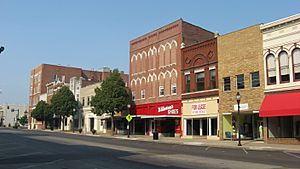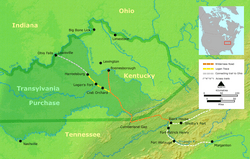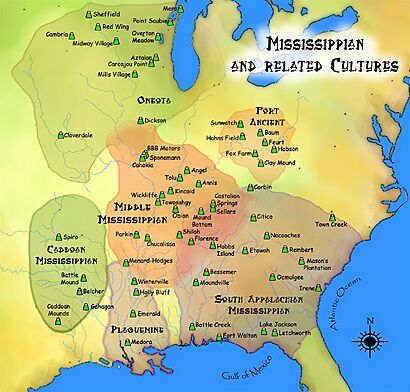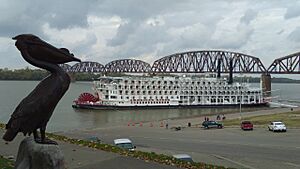Henderson, Kentucky facts for kids
Quick facts for kids
Henderson, Kentucky
|
||
|---|---|---|

North Main Street
|
||
|
||

Location of Henderson in Henderson County, Kentucky.
|
||
| Country | United States | |
| State | Kentucky | |
| County | Henderson | |
| Established | 1797 | |
| Incorporated | 1840 | |
| Named for | land speculator Richard Henderson | |
| Area | ||
| • Total | 18.39 sq mi (47.63 km2) | |
| • Land | 16.11 sq mi (41.73 km2) | |
| • Water | 2.28 sq mi (5.90 km2) 13.01% | |
| Elevation | 407 ft (124 m) | |
| Population
(2020)
|
||
| • Total | 27,981 | |
| • Estimate
(2022)
|
27,697 | |
| • Density | 1,736.66/sq mi (670.51/km2) | |
| Time zone | UTC−6 (CST) | |
| • Summer (DST) | UTC−5 (CDT) | |
| ZIP Codes |
42420, 42419
|
|
| Area code(s) | 270 & 364 | |
| FIPS code | 21-35866 | |
| GNIS feature ID | 0494023 | |
Henderson is a city located along the Ohio River in Henderson County, Kentucky, United States. It is the main city of Henderson County. In 2020, about 29,781 people lived there. Henderson is part of a larger area that includes Evansville, Indiana, and is often seen as Evansville's southern neighbor.
Contents
Discovering Henderson's Past
Early Days and Native Americans
People have lived in what is now Kentucky for a very long time, possibly since 9,500 BCE or even earlier. Around 800 CE, a group called the Mississippian culture lived here. They were a Native American civilization that thrived across the Midwestern, Eastern, and Southeastern United States. Most of their settlements had changed or disappeared by 1500.
Later, the Yuchi, Shawnee, and Eastern Band of Cherokee Indians lived in the Henderson area. Many important items from these tribes and earlier peoples have been found since the 1700s.
How Henderson Began
Henderson started as a small village called "Red Banks." It was named for the reddish clay cliffs overlooking the Ohio River. The city was later named after Richard Henderson, a pioneer and land investor. Henderson County is also named after him.
In 1775, Richard Henderson tried to buy a huge amount of land from the Cherokee people. This land was between the Ohio, Cumberland, and Kentucky rivers. This deal, known as the Transylvania Purchase, was later canceled. However, Henderson and his company were given 200,000 acres of land to develop. This land was located where the Green River meets the Ohio River.
By the early 1790s, Red Banks had a tavern and several European-American families living alongside the local Cherokee. In 1797, Samuel Hopkins and Thomas Allin planned the future town of Henderson. The Kentucky legislature officially established it that same year. The town was designed with very wide streets. This was to help stop fires from spreading easily from one block to another. Even today, the streets are wide enough for two-way traffic and parking. By 1799, Henderson had 183 people.

Growth in the 1800s
A post office opened in Henderson in 1801. The city officially became a town on January 21, 1840. In the mid-1800s, Henderson County became a major producer of tobacco. Much of this tobacco was sent to Great Britain. The area was known as the world's largest producer of dark tobacco. Large tobacco warehouses and factories were common in downtown Henderson.
The 1900s and Beyond
Before World War I, Henderson was said to have many wealthy people. However, after the war, Great Britain placed high taxes on imported tobacco. This hurt Henderson's tobacco export business. Tobacco warehouses and plants closed, and the city's economy changed. The last tobacco facility closed in 1984.
Henderson continued to be an important regional center. In the early 1900s, areas like Audubon and Weaverton became known neighborhoods. In 2008, a sad event happened at an Atlantis Plastics factory in Henderson.
Geography and Climate
Where is Henderson?
Henderson is in north-central Henderson County. It is about 10 miles south of Evansville, Indiana, and 30 miles west of Owensboro, Kentucky. The city covers about 18.39 square miles, with about 2.28 square miles of water. Most of the Ohio River that passes Henderson is within the city limits.
Because the border between Indiana and Kentucky follows the Ohio River, a small part of Henderson County is actually north of the river. This area looks like it's in Indiana. The Bi-State Vietnam Gold Star Bridges and the Ellis Park Race Course horse racing track are both entirely in Kentucky, even though the racetrack uses an Indiana area code.
Weather and Nature
Henderson has hot, humid summers and generally mild to cool winters. It has a humid subtropical climate.
The city has experienced some unusual weather events. In 1901, there was a "great sleet" that lasted for three weeks. In 1908, a severe drought caused the Ohio River to become very low. People could even play baseball in the middle of the old riverbed!
In 1914, Henderson was hit by a "baby cyclone" with large hail and strong winds. Later that month, a tornado struck, causing much damage. In 1937, the Ohio River flood of 1937 caused widespread damage to many cities along the river. However, Henderson, being on a bluff, was mostly spared. This good location helped the city attract new businesses.
People of Henderson
| Historical population | |||
|---|---|---|---|
| Census | Pop. | %± | |
| 1800 | 205 | — | |
| 1810 | 159 | −22.4% | |
| 1830 | 484 | — | |
| 1850 | 1,775 | — | |
| 1870 | 4,171 | — | |
| 1880 | 5,365 | 28.6% | |
| 1890 | 8,835 | 64.7% | |
| 1900 | 10,272 | 16.3% | |
| 1910 | 11,452 | 11.5% | |
| 1920 | 12,169 | 6.3% | |
| 1930 | 11,668 | −4.1% | |
| 1940 | 13,160 | 12.8% | |
| 1950 | 16,837 | 27.9% | |
| 1960 | 16,892 | 0.3% | |
| 1970 | 22,976 | 36.0% | |
| 1980 | 24,834 | 8.1% | |
| 1990 | 25,945 | 4.5% | |
| 2000 | 27,373 | 5.5% | |
| 2010 | 28,757 | 5.1% | |
| 2020 | 27,981 | −2.7% | |
| 2022 (est.) | 27,697 | −3.7% | |
| U.S. Decennial Census | |||
In 2000, there were 27,373 people living in Henderson. About 84.1% of the people were White, and 11.8% were Black or African American. About 23.5% of the population was under 18 years old. The median age was 37 years.
Henderson's Economy
Henderson County has many different industries. These include making aluminum, car and appliance parts, and plastic items. They also do food processing and recycle materials. The county is one of Kentucky's top producers of corn and soybeans. Henderson County is also a leading producer of coal.
Fun Things to Do
Yearly Festivals
Henderson hosts many fun events and festivals each year:
- The Tri-Fest is a street festival in mid-April. It raises money for non-profit groups.
- The Handy Blues and Barbecue Festival is in mid-June. It honors W. C. Handy, who is known as the Father of the Blues. This festival is free.
- The Bluegrass in the Park Folklife Festival happens in August. It is one of the largest free Bluegrass festivals in the country. It celebrates local life and culture with displays on traditional games, crafts like quilting, storytelling, folk music, and food traditions. Famous performers like Bill Monroe and Alison Krauss and Union Station have played here.
- The Henderson Lions Club Arts and Crafts Festival is a big event in October. It takes place at John James Audubon State Park and attracts many visitors.
Places to Visit
- John James Audubon State Park: John James Audubon, a famous bird artist, lived in Henderson for several years. The park has the world's largest collection of his items and art. You can see nine bronze sculptures of birds from his famous Birds of America series in downtown Henderson.
- River Front: The city's downtown riverfront has a play area, a water park, walking trails, and boat docks. It's a great place to relax and enjoy the river.
- Metzger's Tavern: This is the oldest tavern in Kentucky that has been open continuously since 1887.
Education in Henderson
The Henderson County school system has eight elementary schools, two middle schools (North Middle and South Middle), and one high school (Henderson County High School). There is also a center for pre-schoolers and a private Catholic school called Holy Name of Jesus Catholic School.
For higher education, Henderson has Henderson Community College. A branch of Murray State University is also here. Students can also go to universities in nearby Evansville, Indiana, like Oakland City University Evansville Center, the University of Evansville, and the University of Southern Indiana.
Henderson also has a public library, the Henderson County Public Library.
Media and News
Henderson has a local daily newspaper called The Gleaner. You can also read the Evansville Courier & Press. For radio, WSON (860-AM) is the only local station broadcasting from the city.
Getting Around
Transportation
The Henderson Area Rapid Transit (HART) system was created in 1957. It is a public transportation system that serves the citizens of Henderson.
- Interstate 69 (I-69) in Kentucky ends near Henderson. There are plans to extend it into Indiana across the Ohio River.
- U.S. Route 41 (US 41) connects Henderson to Evansville, Indiana, to the north using the Bi-State Vietnam Gold Star Bridges. To the south, it connects to cities like Madisonville and Hopkinsville.
Famous People from Henderson
Many notable people have connections to Henderson:
Arts and Culture
- Young E. Allison: Writer and editor.
- John J. Becker: Composer.
- Teddy Darby: A blues musician.
- Joey Goebel: Author.
- Gregg Hale: Film producer, known for Blair Witch Project.
- W.C. Handy: A famous African-American blues legend who spent about ten years in Henderson.
- Rosa Henderson: An American jazz and blues singer.
- Grandpa Jones: A banjo player and comedian, born in Henderson County.
Military Heroes
- Adam Johnson: A Confederate general during the American Civil War.
- Rear Admiral Husband E. Kimmel: Commander of the U.S. Pacific Fleet during the attack on Pearl Harbor.
- Command Sergeant Major Gary L. Littrell: Received the Medal of Honor for his service in the Vietnam War.
- Corporal Luther Skaggs, Jr.: Received the Medal of Honor for his service in World War II.
Business Leaders
- Amos G. Rhodes: A furniture business owner.
- Don Ball: A businessman and founder of Ball Homes.
Science and Research
- John James Audubon: A famous bird scientist who lived in Henderson.
- Darrell A. Posey: An anthropologist who studied cultures and nature.
Sports Stars
- Clarence Adams: A professional boxer.
- Sam Ball: A former NFL player.
- Stephen Bardo: A former NBA player.
- Junius Bibbs: A baseball player who won three Negro leagues championships.
Henderson in Movies
Henderson has been a filming location for some movies:
- Some scenes from A League of Their Own, directed by Penny Marshall, were filmed in Henderson in 1991. This included scenes at the house where the team lived on Main Street.
- The horse betting scene in Traveller (1997), starring Bill Paxton and Mark Wahlberg, was filmed at Ellis Park in 1995.
See also
 In Spanish: Henderson (Kentucky) para niños
In Spanish: Henderson (Kentucky) para niños




